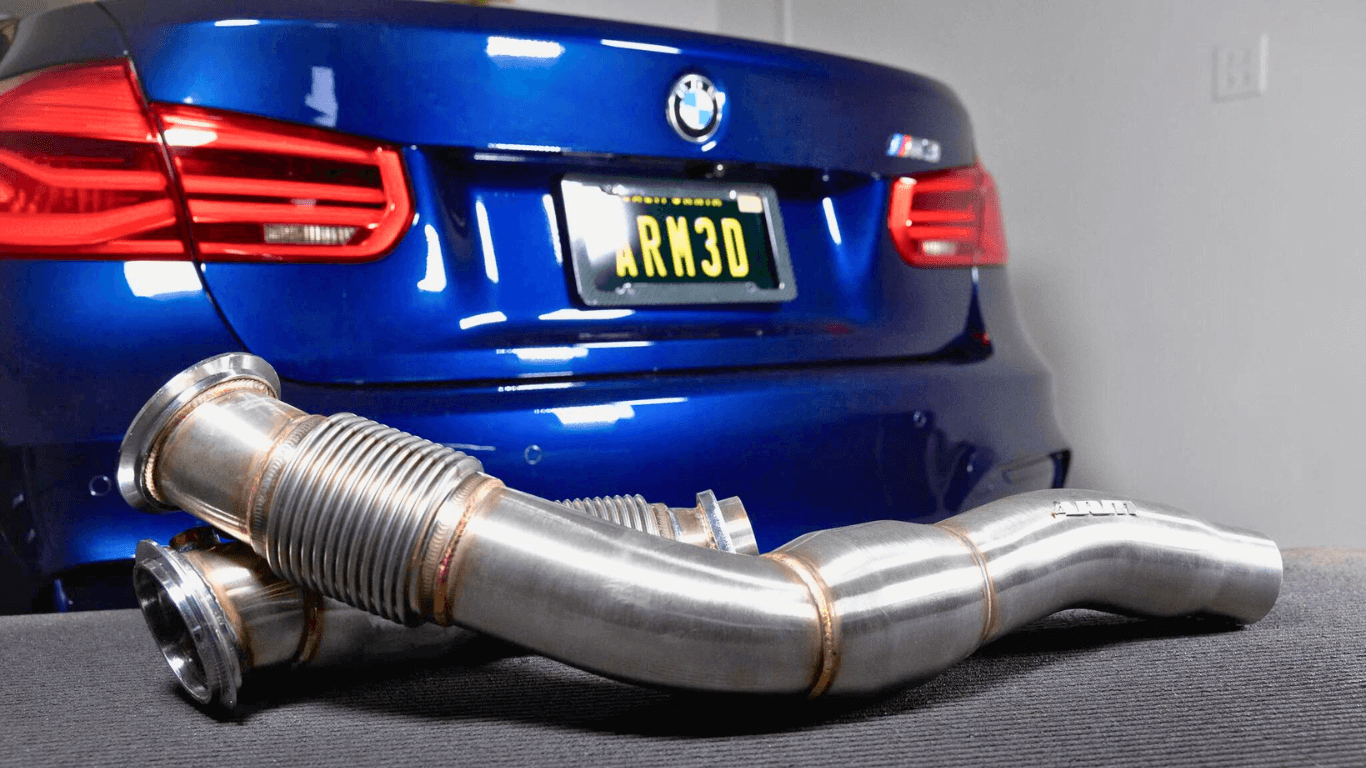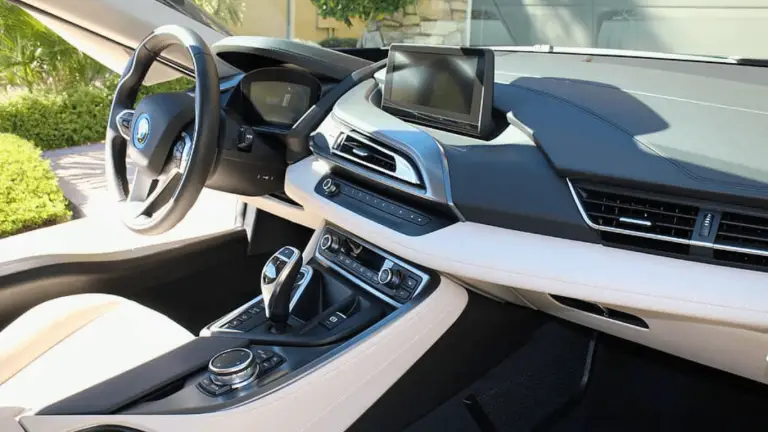Complete Guide to BMW M4 Downpipes: Performance, Sound, and Install
If you own the incredible BMW M4, you likely want to unleash its full potential and get the most out of its powerful turbocharged engine. One of the best places to start is by upgrading the downpipes.
Aftermarket downpipes can provide significant horsepower and torque gains by improving airflow and reducing restrictions. But what exactly are downpipes and how do they affect performance?
This comprehensive downpipes guide will cover everything an M4 owner needs to know:
- What are downpipes and why upgrade them?
- Benefits of BMW M4 aftermarket downpipes
- Best downpipe designs and brands
- How downpipes change the M4’s sound
- Downpipe installation guide
- Important considerations before modifying exhaust
By the end you’ll understand how downpipes work, their performance benefits, and how to choose the best setup for your BMW M4.
What Are Downpipes and Why Upgrade Them?
On a BMW M4, the downpipes are the section of exhaust piping that connect directly to the turbocharger outlets. They route exhaust gases from the turbochargers down to the rest of the exhaust system.
The factory downpipes on an M4 are relatively restrictive due to their smaller diameter piping and catalytic converters. This creates added backpressure which limits exhaust flow.
Many M4 owners choose to upgrade their downpipes for several key reasons:
- Reduce exhaust flow restrictions
- Improve turbocharger response and decrease lag
- Enhance exhaust gas velocity for better turbo spool
- Allow more air to escape faster from the motor
On forced induction cars like the M4, minimizing exhaust system bottlenecks is one of the most effective ways to release additional horsepower and torque.
Upgraded downpipes are a popular first mod as they complement other intake and engine upgrades. Let’s look closer at the benefits you can expect by installing aftermarket M4 downpipes.
Benefits of Aftermarket M4 Downpipes
High quality aftermarket downpipes provide significant benefits over the stock restrictive piping:
Increased Horsepower and Torque
One of the biggest advantages of upgraded downpipes is substantial horsepower and torque gains throughout the powerband.
Many M4 owners see an extra 20-30 horsepower to the wheels after installing downpipes and tuning the ECU. Some dyno tests have shown gains of over 40 hp!
Along with more top end power, you’ll also notice more torque available at low to mid RPMs. This improves acceleration right off the line.
Faster Turbocharger Response
The stock M4 downpipes use pinched piping and restrictive catalytic converters that create turbulence in the exhaust flow.
Aftermarket downpipes have smooth mandrel bent piping and high flowing cats. This allows exhaust gases to evacuate faster from the turbochargers.
The result is improved turbo response and reduced lag. More responsive turbos gives a more linear power delivery with less abrupt on/off-throttle transitions.
Increased Airflow Efficiency
The smoother internal surface and larger diameter of aftermarket downpipes allows exhaust gases to flow out with less resistance.
This reduces backpressure which means more engine energy is transferred directly into power instead of being wasted fighting exhaust restrictions.
Better Performance With Other Mods
Downpipes are a crucial supporting mod that complements upgrades like intakes, intercoolers, tune, etc.
Opening up the exhaust system allows the engine to benefit fully from added airflow from other intake and engine mods.
On a completely stock M4, downpipes alone make a noticeable difference. But they really shine on tuned cars making over 500 hp.
Now that you understand the benefits of upgraded BMW M4 downpipes, let’s look at which design and brand is best for your needs.
Choosing the Best Downpipe Design and Brand
Downpipes are available for the M4 in three main configurations:
- Catless downpipes – no catalytic converters
- High-flow catted downpipes – 200 cell high flow cats
- Catted downpipes – series of standalone catalytic converters
Let’s compare the pros and cons of each design:
Catless Downpipes
Pros:
- Maximum flow capability and power gains
- Aggressive exhaust tone when combined with other mods
Cons:
- Not legal/compliant in many areas due to no cats
- More likely to trigger check engine lights
High-Flow Catted Downpipes
Pros:
- Increased flow over stock and moderate power gains
- Keeps the exhaust highway legal and compliant
Cons:
- Not as free-flowing as catless option
- Requires tuning to prevent CELs
Catted Downpipes
Pros:
- Completely emissions compliant configuration
- Requires no tune while minimizing CEL risks
Cons:
- Extra cats slightly reduce power vs high-flow option
- Sound is closer to stock
For most, high-flow catted downpipes offer the best mix of increased flow and performance while maintaining legal compliance in areas with inspections.
They nearly match the peak power of catless downpipes when paired with ECU tuning.
Top M4 Downpipe Brands
Some popular brands that make high quality downpipes for the BMW M4 include:
- VRSF – Well designed downpipes with generous 3″ piping. Offered in catless and high-flow catted versions. One of the best options for M4s.
- Agency Power – Aggressive looking downpipe with smooth bends. High-flow 200 cell cats don’t restrict flow.
- Road Racing Core – Proven RRC downpipes with tight mandrel bends for turbulence free exhaust gas flow.
- ARM – Multiple configurations like the catless ARC-X crossover and catted Touring option are available.
Things to look for when choosing a brand:
- Material Quality – Look for T304 stainless steel or higher grade. Avoid cheap mild steel prone to corrosion. Titanium is lightweight but very costly.
- Piping Diameter – Larger is better. Look for 2.5″-3″ piping for high flow capacity on M4 downpipes.
- Construction – Mandrel bent options without crush bends keep exhaust velocity high. Ensure smooth internal welds.
- Coatings – Silver ceramic, titanium nitride, etc. coatings help manage heat and reduce discoloration.
Once you select the design and brand, you’ll be ready to enjoy the changes in sound after installing M4 downpipes.
Will Downpipes Change the Sound of My BMW M4?
One of the most exciting benefits of upgraded downpipes is the new beastly sounds they unlock from the M4’s turbo inline-6.
Owners describe the sound with downpipes as deeper, louder, more exotic, and more like a race car.
Here’s a closer look at how downpipes impact the acoustic profile of your BMW M4:
Increased Volume
Downpipes make the exhaust note noticeably louder at idle, during acceleration, and at high RPMs. It better highlights the unique sound of the BMW S55 twin-scroll turbo engine.
High flow cats or especially catless downpipes create the biggest increase in loudness over stock. Sound levels are still civilized during cruising but open up when you step on it.
More Turbocharger Spool Audible
The large diameter piping in aftermarket downpipes reduces muffling of the turbocharger.
You’ll hear more of thesignature turbo spool up and blow off sounds. This audible reminder of the turbos adds to the sports car experience.
Deeper Tone
Aftermarket downpipes create a deeper, more muscular exhaust tone compared to the thin, restrictive stock pipes.
The M4 snarls, barks, and roars louder with each shift, especially in the upper rev ranges above 4500 RPM. Burbles and pops on overrun become more prominent too.
Modifications Create The Biggest Change
To really wake up the M4’s sound, pair downpipes with other mods like a cat-back exhaust, intake, and tune. This opens up the whole system.
Catless downpipes make the biggest sound change – unleashing the most volume and turbo noise. Though they may exceed legal sound limits.
Overall, downpipes allow your M4’s unique turbo I6 personality shine through. Now let’s cover proper installation.
Downpipe Installation – What’s Involved?
Downpipe installation takes between 3-6 hours depending on your skill level and workshop tools. Plan for a full afternoon to remove the stock piping and install the new downpipes. Here is an overview:
Tools Needed
- Socket wrench and sockets
- Pliers
- Jack and jack stands
- Torx bits
- Anti-seize lubricant
Steps for Install
- Lift and secure the vehicle safely on stands
- Loosen exhaust clamps behind downpipes
- Remove fasteners holding downpipes to turbochargers
- Detach downpipe hanger bracket from chassis
- Carefully slide stock downpipes off turbo outlets
- Transfer or replace the exhaust gaskets
- Install new downpipes and fasten to turbos securely
- Attach hangers and support brackets
- Reconnect downpipes to midpipe and tighten clamps
- Start the car and check for leaks before lowering
An experienced mechanic can typically knock out the entire downpipe swap in 2-3 hours. Take your time and work slowly if attempting your first exhaust project.
Having the car tuned after installing downpipes is highly recommended. A proper ECU tune will prevent throwing codes for the oxygen sensors and check engine lights.
The M4 will feel more responsive right away. But fine tuning maximizes the performance gains.
Important Considerations Before Modifying M4 Downpipes
While downpipe upgrades provide substantial benefits, there are some important considerations to make before modifying your BMW M4’s exhaust:
Legal Compliance
In regions with strict emissions laws, installing catless downpipes may not be street legal. Avoid noise citations and issues passing inspections by using catted options.
Engine Codes
The oxygen sensors will detect the changes in airflow and exhaust. This often triggers check engine lights without re-tuning the ECU.
Cabin Noise
More interior exhaust noise is unavoidable. Use sound damping if you find droning unpleasant. Headphones also help on long drives.
Fitment
Ensure you order the correctly fitting downpipes for your specific M4 model and year. Proper alignment is critical.
Exhaust Smell
Catless downpipes can sometimes introduce exhaust odor into the cabin at idle. Keep this in mind for daily driving.
As long as you plan accordingly, upgraded downpipes are one of the best bang-for-buck upgrades for the BMW M4.
The combination of increased horsepower, aggressive sound, and improved turbo response completely transforms the driving experience.
Conclusion
We hope this complete guide to BMW M4 downpipes has provided everything you need to know to decide if upgrading is worthwhile for your car.
Here’s a quick recap of the benefits that high flowing aftermarket downpipes offer:
- Horsepower and torque gains throughout the powerband
- Reduced turbo lag for more responsive acceleration
- Increased airflow efficiency for more power
- Louder, deeper exhaust tone that enhances the M4’s personality
- Easy DIY install for a full afternoon
Choosing the right downpipe design and brand that fits your goals, budget, and local laws is key. Names like VRSF, Agency Power, and ARM offer quality options.
Downpipes pair perfectly with other mods and tuning to unlock the M4’s full performance potential. Just be aware of potential drone/smell, engine codes, and legal compliance.
We hope this guide gave you confidence to move forward and get the most performance from your BMW M4! Let us know if you have any other questions.







